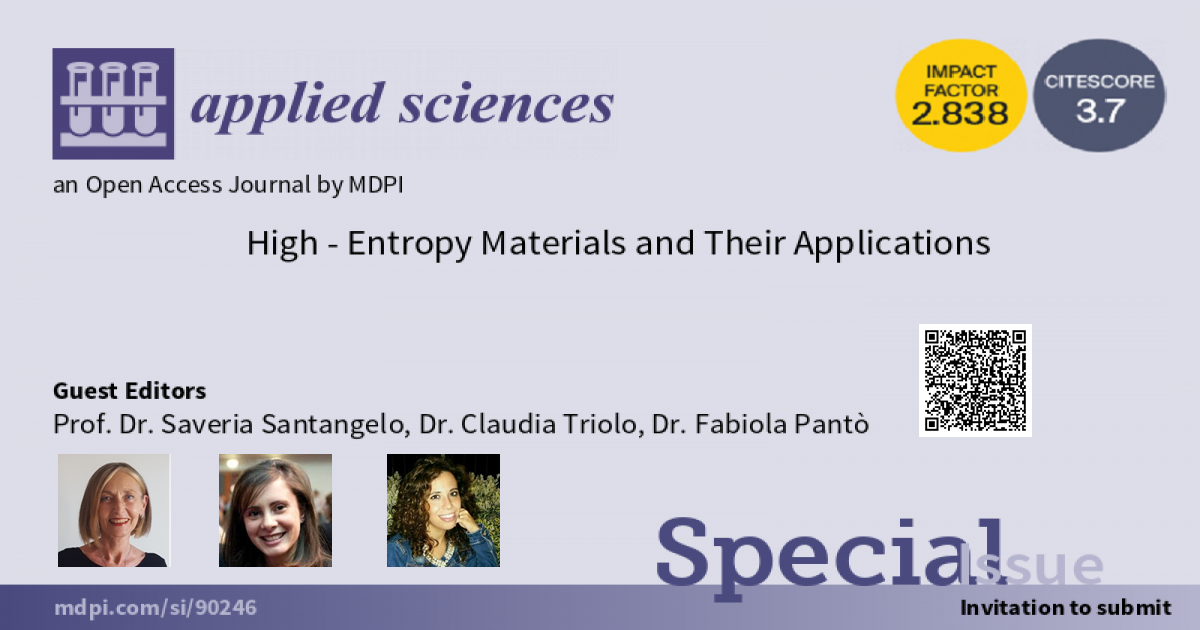- 2.5Impact Factor
- 5.5CiteScore
- 20 daysTime to First Decision
High-Entropy Materials and Their Applications
This special issue belongs to the section “Materials Science and Engineering“.
Special Issue Information
Dear Colleagues,
Highientropy materials (HEMs), an emerging class of single-phase solid solutions composed of a large number of species, are gaining increasing scientific and applicative interest thanks to the possibility of suitably tailoring their structural and functional properties through the choice of proper element combinations and/or proportions. The strong synergistic effects among the constituent species result in enhanced performance compared to conventional compounds.
Among HEMs, particular attention is presently focused on high-entropy oxides (HEOs) and alloys (HEAs), which look to be very appealing materials for energy-related applications, such as energy production and storage.
Although many aspects concerning the role of entropy, enthalpy, individual elements and synergy arising from the presence of multiple elements of their structure have been investigated, open queries still require further research efforts.
This Special Issue aims to depict the state of the art of this hot topic, both in terms of goals achieved and challenges to be faced and to draw the possible future scenery for developing HEMs with fully controllable properties. Contributions from all researchers (material scientists, chemists, physicists, engineers, etc.) on the following topics are welcome.
Prof. Dr. Saveria Santangelo
Dr. Claudia Triolo
Dr. Fabiola Pantò
Guest Editors
Short Biography
Prof. Dr. Saveria Santangelo is an Associate Professor of Experimental Physics (Dept. of Civil, Energy, Environmental and Materials Engineering, Mediterranean University of Reggio Calabria, Italy, since 2005), with a National Scientific Qualification as a Full Professor of Experimental Physics (2018).
She is a member of SIF, the Italian Society of Physics (since 1985), of SCI, the Italian Chemical Society—Inter-divisional Group of Raman Spectroscopy and non-linear effects and Renewable Energies, ENERCHEM (since 2008), of INSTM, the National Inter-University Consortium for Materials Science and Technology (since 2017), of GISEL, the Italian National Group for Electrochemical Energy Storage Systems (since 2020), and is the Scientific Director of the research unit of Reggio Calabria of the Italian National Reference Centre GISEL-INSTM (since 2020).
After graduating with a degree in Physics (summa cum laude, Messina University, Italy, 1984), she worked (with fellowships) for 3 years in the field of Li-ion batteries in cooperation with the Italian National Laboratory of Frascati, Rome, Italy. In 1988 she acquired a position as a Researcher (Engineering Faculty of Reggio Calabria University, established in 1983). There, her research work initially centered on the simulation of electron scattering in solids via the Monte Carlo method for applications in e-beam lithography, and her efforts were devoted to setting up a Raman spectroscopy lab. Subsequently, she developed an experimental research line focused on the design, synthesis, and analysis of carbon-based materials for electronic applications.
Currently, she is the Scientific Director of the research line of the Materials for the Environmental and Energetic Sustainability Laboratory, focused on the design, synthesis (preferentially via electro-spinning), and analysis of nanostructured materials for applications in energy storage and conversion, water treatment, catalysis, photo-catalysis, and sensing.
She has authored 172 publications in peer-reviewed international scientific journals, co-edited two books (GNSR 2001, IOS Press; Carbon: the future material for advanced technology applications, Springer), and for the year 2020 she has been ranked among the “Top 2% Scientists of the world” (https://elsevier.digitalcommonsdata.com/datasets/btchxktzyw/3).
Manuscript Submission Information
Manuscripts should be submitted online at www.mdpi.com by registering and logging in to this website. Once you are registered, click here to go to the submission form. Manuscripts can be submitted until the deadline. All submissions that pass pre-check are peer-reviewed. Accepted papers will be published continuously in the journal (as soon as accepted) and will be listed together on the special issue website. Research articles, review articles as well as short communications are invited. For planned papers, a title and short abstract (about 250 words) can be sent to the Editorial Office for assessment.
Submitted manuscripts should not have been published previously, nor be under consideration for publication elsewhere (except conference proceedings papers). All manuscripts are thoroughly refereed through a single-blind peer-review process. A guide for authors and other relevant information for submission of manuscripts is available on the Instructions for Authors page. Applied Sciences is an international peer-reviewed open access semimonthly journal published by MDPI.
Please visit the Instructions for Authors page before submitting a manuscript. The Article Processing Charge (APC) for publication in this open access journal is 2400 CHF (Swiss Francs). Submitted papers should be well formatted and use good English. Authors may use MDPI's English editing service prior to publication or during author revisions.
Keywords
- syntheses and structures of HEMs
- new synthesis techniques
- nanosized HEMs
- HEMs’ characterization
- HEM-based solid-state batteries components
- HEM-based catalysts and electrocatalysts
- other HEM applications
- theoretical studies

Benefits of Publishing in a Special Issue
- Ease of navigation: Grouping papers by topic helps scholars navigate broad scope journals more efficiently.
- Greater discoverability: Special Issues support the reach and impact of scientific research. Articles in Special Issues are more discoverable and cited more frequently.
- Expansion of research network: Special Issues facilitate connections among authors, fostering scientific collaborations.
- External promotion: Articles in Special Issues are often promoted through the journal's social media, increasing their visibility.
- e-Book format: Special Issues with more than 10 articles can be published as dedicated e-books, ensuring wide and rapid dissemination.

